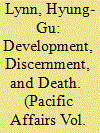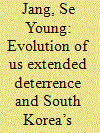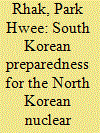| Srl | Item |
| 1 |
ID:
169214


|
|
|
|
|
| Summary/Abstract |
Ron Dore’s 1977 article in Pacific Affairs, “South Korean Development in Wider Perspective,” is a rare example of the scholar known for his writings on Japan applying his analytical lens on South Korea. What were some of this article’s most notable areas of foresight and elision related to development studies? This essay answers this question by interpreting connections to publications before and after 1977 to analyze areas of insight under the rubric of “discernment” and overlooked subjects under “death.” On one hand, Dore’s essay was ahead of the curve in its deft foreshadowing of post-developmentalist, varieties of capitalism, and developmental state approaches to economic development. On the other, Dore sidestepped the effects of death on economic development in three forms: literal—effects of changing mortality rates on investments in education and human capital; industries related to death—wars, munitions production and arms expenditures; and the aftereffects of the death of a scholar—the revisiting and renewal of debates that can sometimes emerge as a result.
|
|
|
|
|
|
|
|
|
|
|
|
|
|
|
|
| 2 |
ID:
146626


|
|
|
|
|
| Summary/Abstract |
Extended deterrence has been a main pillar of the security alliance between the United States and South Korea (Republic of Korea [ROK]) since the end of the Korean War. The changing dynamics of US extended deterrence in Korea, however, affected Seoul’s strategic choices within its bilateral alliance relationship with Washington. Examining the evolution of US extended deterrence in the Korean Peninsula until the Nixon administration, this article explains why South Korea began its nuclear weapons programme in a historical context of the US–ROK alliance relationship. This article argues that President Park Chung-hee’s increasing uncertainty about the US security commitment to South Korea in the 1960s led to his decision to develop nuclear weapons in the early 1970s despite the fact that US tactical nuclear weapons were still stationed in South Korea.
|
|
|
|
|
|
|
|
|
|
|
|
|
|
|
|
| 3 |
ID:
153509


|
|
|
|
|
| Summary/Abstract |
This paper reviews the current state of South Korean nuclear preparedness and
draws out some necessary tasks for the future. It reviews all available options that a
non-nuclear, threatened country should take in response to the level of the nuclear
threat. These are a diplomatic approach, a preventive strike, deterrence, defense,
civil defense, and negotiations. In conclusion, South Korea has depended too much
on diplomatic solutions in the initial periods of the North Korean nuclear weapons
development. It did not review defense measures in depth and did not consider
the preventive strike option during that period. South Korea procrastinated on its
Ballistic Missile Defense (BMD) construction and did not review the necessity of
nuclear civil defense until the present. South Korean nuclear preparedness appears
to have many shortcomings. South Korea should expedite and improve its BMD
shield as soon as possible. It may need to utilize the preemptive strike capabilities of
the United States to provide more money for its BMD. It needs to prepare nuclear
blast and/or fall-out shelters by efficiently renovating existing conventional shelters
and other underground facilities.
|
|
|
|
|
|
|
|
|
|
|
|
|
|
|
|